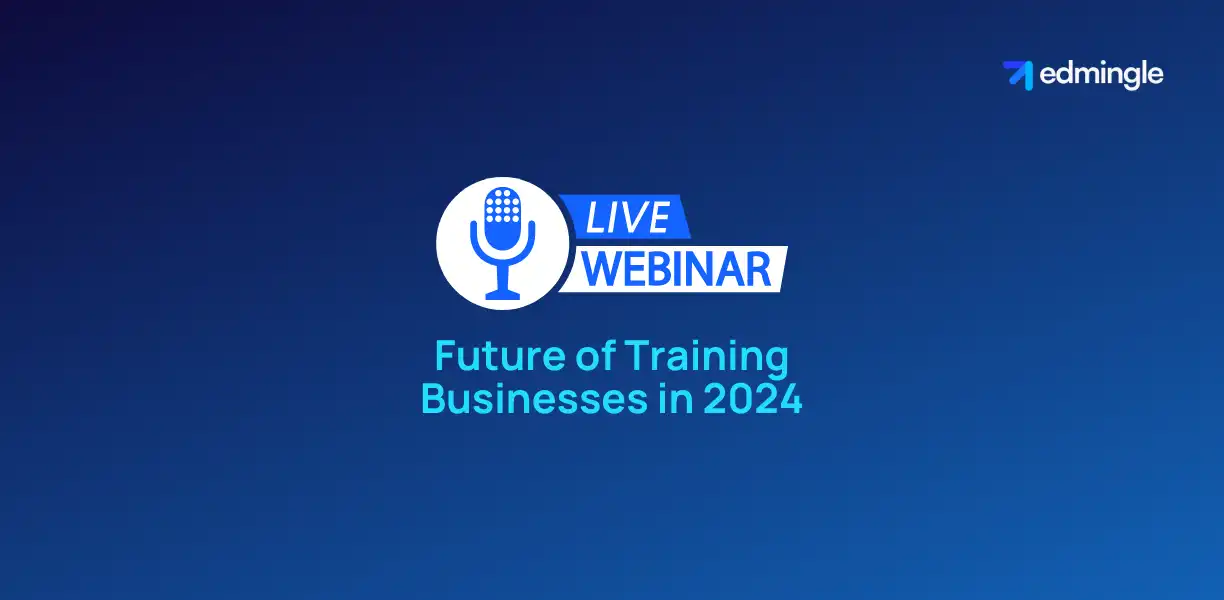
In the recently hosted Edmingle’s webinar by Gaurav Doshi, CEO and co-founder of Edmingle (a pioneer in full-stack training management and analytics), industry professionals gathered to explore the evolving landscape of training businesses.
With over 13 years of experience and having collaborated with 2500+ companies in the ed-tech and skill development sector. Mr. Doshi shared invaluable insights into the challenges & opportunities that lie ahead for the future of training businesses in 2024.
This blog aims to provide a comprehensive recap shared during the session. Focusing on the importance of innovation & strategic planning in future-proofing your training business.
With this, you’ll be able to better strategize your approach. While ultimately driving your training business to profitability & sustainability.
Future of Training Businesses in 2024: The Looming Skill Gap

It was during the pandemic that concerns regarding the skill gap in the workforce started being highlighted.
Despite a staggering $380 billion global investment in L&D, an alarming 87% of CEOs still identify a significant skill gap in their employees.
This paradox highlights a misalignment between training delivery and industry requirements. Thereby, suggesting the need for a more targeted approach to skill development.
Additionally, the fact that knowledge is subjective from the perspective of learners and trainers is a lesser known truth. But it’s changing, gradually.
Amidst this, digital platforms like learning management systems are revolutionizing traditional training models. Mainly by offering unparalleled flexibility, scalability and personalization.
Let’s look at how the landscape of upskilling is changing for a deeper understanding.
The Shifting Landscape of Upskilling & Training Businesses
Today’s era is marked by rapid technological advancements and shifting work paradigms. Hence, the ability to adapt and evolve training methodologies is paramount.
Businesses that can effectively bridge the skill gap. While catering to the unique needs of their audience, they will not only survive but thrive.
Key trends include:
- the rise of digital platforms, and
- the shift towards more specialised & niche-focused training solutions.
Furthermore, technologies like automation & AI are the biggest drivers of accelerated skill shifts. The below chart shows the predicted shift in skill sets looking forward to 2030.
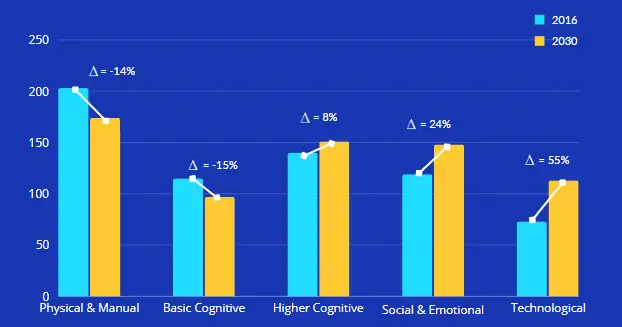
Mr. Doshi emphasised the potential for ed-tech and skill development companies to thrive by focusing on niche markets.
With the demand for specialized skills on the rise. Businesses that offer targeted training solutions can expect substantial growth.
This approach not only meets the immediate needs of the workforce. But also ensures long-term sustainability. By addressing the specific skill shortages across industries.
The Sustainability Equation
One of the highlights of the webinar. The sustainability equation was key to effectively highlighting the future of training businesses in 2024.
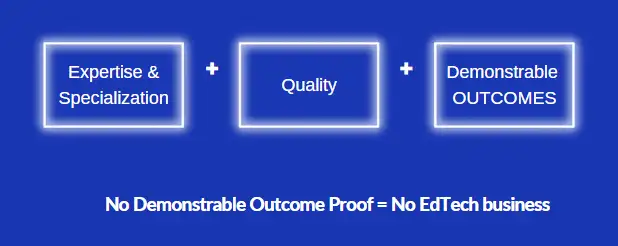
In this, Mr. Doshi underscored that a sustainable ed-tech business model rests on 3 pillars. Expertise & specialisation, quality training and demonstrable outcomes.
- Without expertise and specialization, positioning your business can be challenging.
- Additionally, the lack of quality training delivery leaves learners dissatisfied.
- Consequently, your demonstrable outcomes like learner success rates will fall.
He also emphasised that no edtech business can exist in the absence of a demonstrable outcome. Since there’ll be no strong reason that learners would want to enrol in your online course or training program.
Proposed Strategies to Build a Sustainable EdTech Business
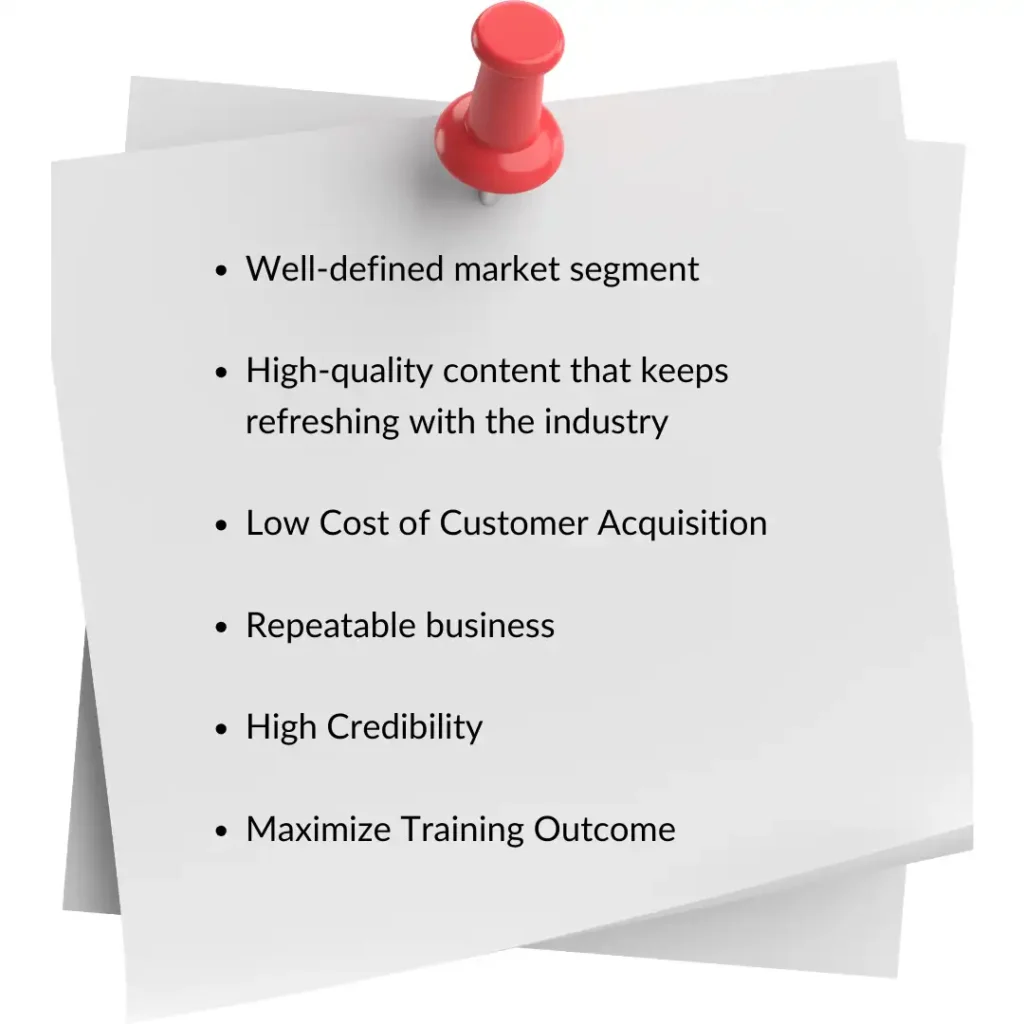
The bottom line of good strategies for EdTech as mentioned by Gaurav, includes the following points:
- Well-defined market segment (builds credibility faster)
- High-quality content that keeps refreshing with the industry (work with B2B)
- Low Cost of Customer Acquisition (ensures quality & dedicated learners)
- Repeatable business (don’t think of scaling in early business stages; and selling)
- High Credibility (finding uniqueness from Day 1 delays your go-to-market time and it’s the market feedback that’ll make you unique; not your innovation on Day 0).
These points would finally lead to maximised training outcomes. Thereby, maximising impact and ensuring the sustainability of training businesses.
Strategies for sustainability include focusing on niche markets, leveraging technology for quality training delivery and ensuring training programs lead to tangible, demonstrable outcomes for learners.
The importance of specialisation, quality training and tangible outcomes is crucial. Yet highly underestimated.
These elements are like a strong foundation. Crucial for building a profitable & enduring business in the competitive landscape of ed-tech.
Exploring the “why” behind this.
The Sustainability Equation – Revisited
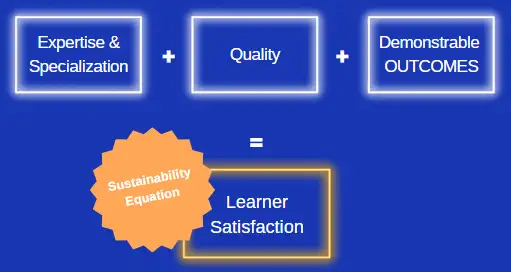
At this juncture, circling back to the original equation. Mr. Doshi highlighted that these 3 pillars supported an important roof; learner satisfaction.
And this entire equation you see, is known as the sustainability equation at Edmingle.
For any edtech business, learner satisfaction is the one metric that will either save the day or break it.
- When learners are satisfied, they’ll be successful and also refer more people to take up your training program.
- But when learners are dissatisfied, it reflects through the outcomes they achieve post-training.
Learner satisfaction can be calculated as a score for a quick reference. It is a composite metric that reflects the effectiveness of training programs. This score is pivotal for understanding and improving the learning experience.
Let’s look at how to calculate this for your training business.
Metrics to Track & Strategies to Improve These Metrics
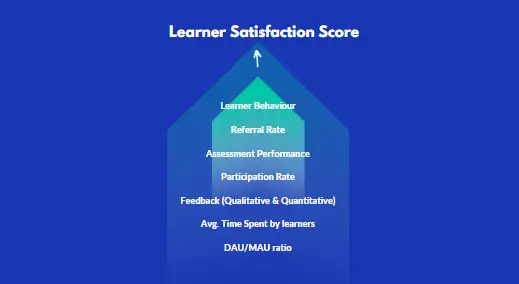
Calculating learner satisfaction as a score, helps you stay on track. Mainly by helping you understand what is working and what’s not.
This calculation is done via key engagement metrics like:
- Learner behaviour (how they interact with course materials, assessments and in social learning forums?)
- Referral rate (how many referrals do you get through your learners?)
- Assessment performance (are learners performing consistently in assessments?)
- Participation rate (how many learners are enrolling, participating and completing the training program end-to-end?)
- Feedback (both qualitative and quantitative)
- Average time spent by learners (on your platform and with your course materials)
- DAU (daily active user) / MAU (monthly active user) ratio
As simple as these might seem, they determine how satisfied a learner is. Thereby, allowing training businesses to focus on the dissatisfied ones and change the scenario.
To further aid this, Edmingle’s analytics tools offer real-time insights into these metrics. Thus, enabling businesses to fine-tune their strategies for better outcomes.
Edmingle Analytics
Since a significant portion of the webinar was also dedicated to discussing the role of technology in bridging the existing skill gap. Mr. Doshi introduced Edmingle’s innovative full-stack training management and analytics platform.
Designed to streamline course delivery operations and provide comprehensive analytics. This tool is pivotal for training businesses. Aiming to enhance their offerings and effectively measure learner satisfaction and engagement.

Edmingle Analytics, a new feature, promises to revolutionise how training businesses measure their success.
By providing detailed insights into learner engagement and satisfaction. It empowers educators to make data-driven decisions & thus, enhance their business outcomes.
To stay updated on this feature or explore our platform closely, book a free demo with our experts.
Future of Training Businesses in 2024: Summary
Edmingle’s webinar on the future of training businesses in 2024 offered a wealth of insights.
These made it clear that the keys to success lie in embracing the right technology, tailoring training to meet specific needs and focusing on measurable outcomes.
In a growingly competitive world, the need of the hour for training professionals, is to adapt and innovate. To ensure their businesses are well-equipped to meet the challenges and opportunities of the future.
Additional Resources: Edmingle’s Webinar
For those interested in watching the webinar from beginning to end, to understand it in depth, click on the button below to access the webinar recording.
Stay tuned for more updates from Edmingle by following us on LinkedIn and prepare to lead the way in the evolving landscape of training and development.
Q&A Session: Edmingle’s Webinar
The webinar concluded with a Q&A session, where participants sought advice on various topics. Here are some of the questions they asked.
1.How can we address the skill gap effectively?
By focusing on niche markets and tailoring training programs to meet specific industry needs. Businesses can offer more relevant and impactful training solutions.
2.What strategies can help training businesses grow?
Specializing in specific skill areas, maintaining high-quality training standards and demonstrating clear outcomes are key strategies for growth.
3.How does Edmingle’s platform assist training businesses?
Edmingle provides a comprehensive solution for managing and delivering training programs. Along with analytics capabilities to track learner engagement and success. Hence, aiding businesses in refining their offerings for maximum impact.
4.What’s the referral rate?
Referrals are one of the fastest and the best ways of marketing for a tech company. A good referral rate is somewhere around 20-25%.

Leave a Reply